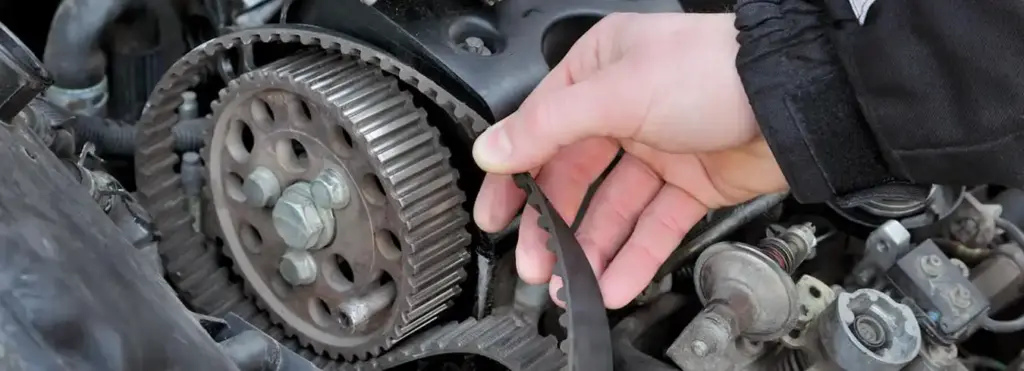You’re cruising down the road, wind in your hair, tunes blasting—life is good. But have you ever wondered what keeps your engine running smoothly behind the scenes? Enter the unsung hero of your car’s internal harmony: the timing belt.
What’s the Deal with Timing Belts Anyway?
Picture this: your car’s engine is like a finely tuned orchestra, with each part playing its unique role to keep the show going. And guess who’s the conductor? That’s right—the timing belt. This rubbery marvel synchronizes the movement of your engine’s crankshaft and camshaft, ensuring everything ticks along perfectly.
Timing Belt: The Engine Maestro
Imagine your engine is a complex dance routine. The crankshaft is leading the steps, while the camshaft is orchestrating the timing of the movements. Now, guess who’s keeping them in perfect sync? Yep, it’s the belt, making sure the pistons and valves don’t collide and ruin the performance.

Timing Belt: The Quiet Achiever
You know those silent, hardworking types who never seek the spotlight but keep everything running smoothly? Well, that’s the timing belt for you. While other engine components might hog the limelight, the belt quietly goes about its business, ensuring your car’s engine runs like a well-oiled machine.
Why Timing Matters with Timing Belts
Imagine trying to play your favorite song with a band where everyone’s out of sync. Chaos, right? That’s what happens when your timing belt isn’t doing its job. Without proper synchronization, your engine’s pistons and valves can collide, leading to a disastrous—and potentially expensive—meltdown.
Timing Belt: The Unsung Hero
Think of your timing belt as the unsung hero of your car’s engine. While it may not be as flashy as a turbocharger or as eye-catching as a sleek paint job, it plays a crucial role in keeping your ride smooth and your engine humming happily. So, the next time you hit the road, take a moment to appreciate the quiet efficiency of your timing belt. After all, it’s the little things that keep life running smoothly.

Signs of a worn-out timing belt
Have you ever noticed your engine sounding like it’s hosting its own drum solo under the hood? That rhythmic slapping or ticking noise might be your timing belt on its last legs. As the belt wears down, it can develop cracks or become misaligned, causing it to slap against the engine components as it spins. So, if you hear your car serenading you with an unusual soundtrack, it’s time to give that timing belt a check-up.
Imagine you’re at a party, and suddenly your friend stops mid-sentence and freezes in place. Awkward, right? That’s kind of what happens when your engine misfires or stalls unexpectedly. Your car’s engine relies on precise timing to function properly, and if the timing belt isn’t doing its job, the engine can lose synchronization, leading to misfires or stalling. So, if your car starts acting like it’s forgotten its lines, it might be trying to tell you something about its timing belt.
Another clue that your timing belt might be ready to retire is if your car suddenly decides to play hide-and-seek with its power. You step on the gas, expecting a surge of acceleration, but instead, you get a sluggish response or intermittent power loss. This could indicate that your timing belt is slipping or has jumped a few teeth, throwing off the precise timing of your engine’s components. So, if your car starts feeling a bit indecisive about its power delivery, it’s worth investigating the timing belt.

Timing Belt Replacement: Your Expert Guide
You’re cruising down the road, wind in your hair, tunes blasting from the speakers—life is good. But wait, what’s that strange noise coming from your engine? Uh-oh, sounds like it might be time to replace your belt! Don’t worry, though; I’ve got you covered with some expert tips on timing belt replacement to keep your ride smooth and your engine purring like a kitten.
1. Know Your Timing Belt Inside Out
Alright, buckle up (pun intended), because we’re diving deep into the world of belts. First things first, what exactly is a timing belt? Well, it’s a crucial component of your engine that synchronizes the rotation of the crankshaft and camshaft, ensuring that your engine’s valves open and close at the right times. Think of it as the conductor of your engine’s orchestra, keeping everything in perfect harmony.
2. Don’t Procrastinate: Timing is Everything
Listen up, fellow drivers: when it comes to timing belt replacement, procrastination is not your friend. Sure, it might be tempting to put it off for a little while longer, but trust me, that’s a gamble you don’t want to take. Timing belts wear out over time, and if yours snaps while you’re cruising down the highway, you could be looking at some serious engine damage—and nobody wants that.
3. Leave it to the Pros: DIY is a No-Go
Now, I know what you’re thinking: “But I’m a DIY wizard! I can tackle anything with a wrench and a YouTube tutorial.” Well, hold your horses there, champ. While I applaud your can-do attitude, replacing a timing belt is no walk in the park. It requires precision, expertise, and specialized tools—things that your average driveway mechanic might not have. So do yourself a favor and leave this job to the pros.

Expert Tips on Timing Belt Replacement
When it comes to timing belt replacement, timing is everything. Literally. Your timing belt plays a crucial role in keeping your engine running smoothly, so don’t neglect it. Make sure you understand what a timing belt does and why it’s important. And most importantly, don’t try to tackle this job yourself unless you’re a certified automotive professional. Trust me, it’s worth the investment to have it done right the first time.

Choosing the Right Time for Replacement
So, how do you know when it’s time to replace your timing belt? Well, there’s no hard and fast rule, but most experts recommend replacing it every 60,000 to 100,000 miles. Of course, this can vary depending on your vehicle’s make and model, so be sure to check your owner’s manual for specific recommendations. And if you’re not sure whether your belt needs replacing, don’t hesitate to consult a mechanic. It’s better to be safe than sorry!
Maintaining Optimum Performance: Your Schedule for Success
Hey there, fellow road warriors! Are you ready to keep your ride running like a dream? Buckle up because I’ve got the lowdown on the maintenance schedule you need for optimum performance—timing belt included!
1. The Power of Regular Maintenance
Alright, folks, let’s kick things off with a truth bomb: regular maintenance is the key to a happy, healthy vehicle. Just like you need regular check-ups to stay in tip-top shape, your car needs some TLC too. From oil changes to tire rotations, staying on top of your maintenance schedule can help prevent costly repairs down the road.
2. Timing is Everything: Your Timing Belt’s BFF
Now, let’s talk about everyone’s favorite engine component: the belt. This little guy may be small, but it plays a big role in keeping your engine running smoothly. That’s why it’s essential to include timing belt inspections and replacements in your maintenance schedule. Trust me, you don’t want this little belt to cause big problems!
3. Crafting Your Perfect Maintenance Schedule
So, how do you craft the perfect maintenance schedule for your vehicle? Well, it’s all about finding the right balance between following your manufacturer’s recommendations and paying attention to your car’s individual needs. Start by checking your owner’s manual for guidelines on when to perform routine maintenance tasks, like oil changes and filter replacements. Then, consider factors like your driving habits, mileage, and the age of your vehicle to tailor your schedule accordingly.
The Ultimate Maintenance Schedule for Optimum Performance
Maintaining your vehicle doesn’t have to be rocket science. With a little bit of planning and know-how, you can keep your ride running smoothly for years to come. Start by sticking to a regular maintenance schedule that includes all the essentials, from oil changes to tire rotations. And don’t forget about your timing belt! Be sure to inspect it regularly and replace it according to your manufacturer’s recommendations. By staying proactive and taking care of your car’s needs, you’ll be cruising down the road in style for miles and miles. Happy driving!

